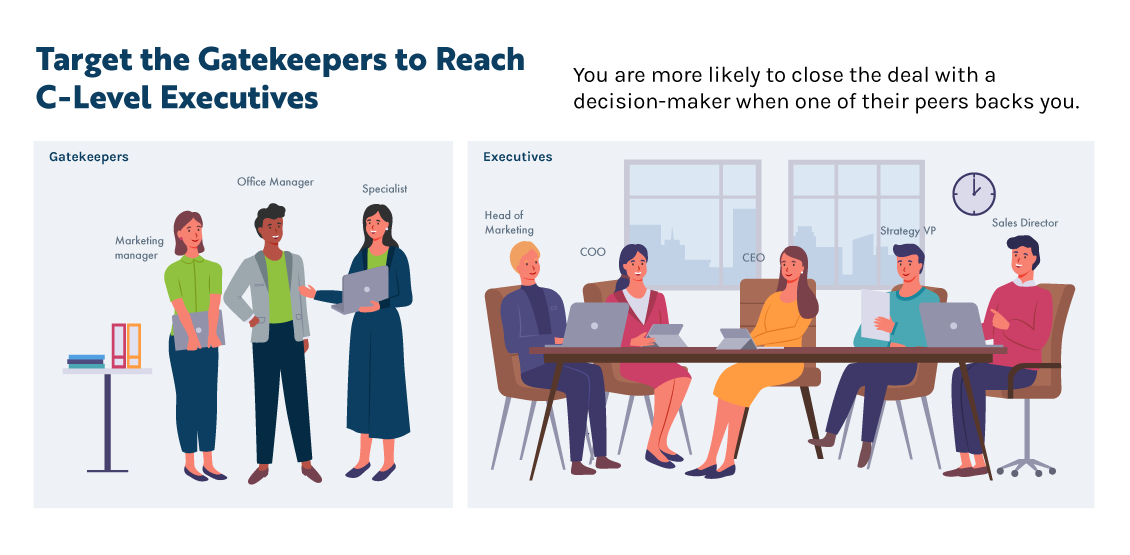When it comes to engaging the C-suite, an email from sales just won't cut it. CEOs and other CXO-level executives are typically under a lot of pressure, have competing demands on their time, and are bombarded by salespeople every day. It's no wonder they have become numb to the onslaught of offers placed before them.
So, how can you get in front of the C-suite and add value to their already hectic workload? Better yet, how can you prove that you have the answer to their challenges and secure a meeting to present them with a path to more strategic growth?
If your current strategy for engaging with the C-suite is underperforming, continue reading to learn our practiced and proven tips on how to reach and engage C-level executives.
In the first few seconds that you're engaging with a decision-maker, they don't trust you. From their perspective, you are simply trying to sell and don't have enough insights into their business to possibly know the challenges they face. So how do you prove them wrong? By being prepared, very prepared.
Here's what you should know before picking up the phone or sending an email:
In any relationship, you can only relate to what you are willing to understand.
When you have a general idea of your prospect's KPIs, you've taken time to walk in their customers' shoes, and you know what their competitors are doing, you can present them with new ideas for achieving success that will grab their attention.
Once you've established that credibility, you can confidently come to the table with statistics, case studies, content, and strategies that support your message.
“The first thing I do when calling a prospect is look for something to reference. I'll research any newsworthy topics to mention, such as a merger, acquisition, or layoffs. If I find something, I can warm up my call with ‘I was reading online…and I thought the timing might be perfect to discuss…’"
Heidi Hacker, Senior Sales Development Specialist
C-level decision-makers are not focused on day-to-day efficiencies or project-based solutions. These types of offerings will go ignored and seen as a waste of their time. Instead, the executive branch is far more focused on dollar-based growth. They're looking at corporate strategic goals, revenue growth, innovation, and how to deliver the company's vision. Therefore, any statistics you present should be based on potential growth in dollars, not productivity, cost savings, or brand lift.
“Whatever message I am delivering, I make sure that it’s backed up with relevant information that applies to the prospect’s unique challenges. Once I establish that I understand their needs, I can share how the product or service can fill any gaps and provide a solution."
Terri-Lynne Anderson, Sales Leader / Talent Manager
As we mentioned, executive buyers have become numb to the bombardment of outreach projected at them. Therefore, they often rely on a trusted source such as peers, assistants, or colleagues – to determine what makes it to their inbox.
On the flip side, if you reach the C-suite first and they need buy-in from other decision-makers, you're much more likely to close the deal when one of their peers backs you. That's why referrals in either direction are the fastest way in the door and why brand nurturing is essential to piquing the interest of the right person. Here are a couple of situations where you can target the gatekeeper to make it on the calendar of top executives.

Many marketers spend a portion of their day sifting through blogs, webinars, news articles, and more, gathering the latest marketing and sales insights. Since they are qualified prospects, you regularly target them with valuable and practical thought leadership content that helps them navigate their challenges. When their executive brings a larger problem to the table, the marketing manager researches the topic and downloads a resource you created that addresses the specific need. A well-crafted resource increases the possibility of them passing it off to corporate-level executives.
Now that your content is in the hands of the right decision-maker, they see that you understand the problem they face and can address it. By presenting yourself as an expert, you are seen as a credible source, warming them to a first call from you when you reach out to the company.
In this scenario, you conduct outreach via phone and email to the office manager of a mid-sized organization. The first time you reach them, they seem interested but need to confirm with multiple decision-makers before booking a meeting. Do you wait until they get back to you? Of course not. You reach out a week or two later, recall the challenge you discussed in the last conversation, and bring a solution to the table now that you've had time to research. Not only have you given the office manager time to digest and delegate, but you've provided new ideas that they can bring up in the next conversation with their higher-ups.
You reach a specialist during your initial qualification call with a prospective company. Instead of pitching your idea, ask them two questions:: "Are you the right person to talk to about XYZ? If not, then who would be?" The specialist recommends you talk to the VP of Strategy and you ask more questions to dig for information about that person's position and focus. You've now become a trusted referral, and you know what to research before contacting the VP.
“I look at my database on the company level and see if I've had any conversations with someone there so I can mention a name. Even if it's not a referral, I might name-drop and say, ‘I spoke with so-and-so and then realized I should reach out to you directly.’"
Heidi Hacker, Senior Sales Development Specialist
It's great to be a reliable vendor or partner, but it's something else to be a trusted advisor. A trusted advisor is someone a client can come to in times of stress for help finding solutions to problems, someone who continuously proves that they care about the success of the business, not just their own.
Executives focus on innovation and organizational change and always look for a fresh perspective, so they turn to their trusted advisors. As a subject-matter expert, you can propose ideas they have not thought of – ideas that go beyond your product or service and provide value across the organization.
The most effective way to do this is by proving that you own the outcome of your efforts and that you will do whatever it takes to help them achieve their goal. It starts by confidently setting action steps at the very beginning – from a booked meeting to a signed contract to a kick-off call and beyond. Once you have the okay to move forward, don't wait for your new client to plan the next steps. Take the initiative in every interaction and always look for ways to bring an extra boost of value.
Every business is different, and what works for one company may not work for the other. If you are struggling to reach and engage the C-suite, try one of these tips to help you get in front of your target decision-makers. While challenging, it certainly is not impossible!
Here at MarketLauncher, engaging with the C-suite has been part of our DNA since before we began, when I spent five years helping Inc. Magazine launch a nationwide peer group program for CEOs of fast-growth companies. Once I had perfected the model and booked hundreds of meetings for pre-qualified CEOs, I started MarketLauncher to bring these tactics to a wider audience. Our team of Market Research and Sales Development Specialists have decades of experience engaging with C-suite decision-makers across a variety of industries.
If you'd like to learn more about our process or share your own tips for engaging the C-suite, I'd love to hear your thoughts.





Privacy Policy | MarketLauncher All Rights Reserved 2023